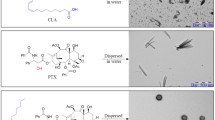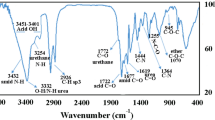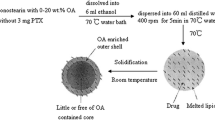Abstract
The current study elucidates the improved drug loading of paclitaxel (PTX) in lipid- and d-α-tocopheryl polyethylene glycol succinate (TPGS)–based core–shell-type lipid nanocapsules (PTX-TPGS-LNC) for augmenting the therapeutic efficacy and curbing the toxicity. PTX-TPGS-LNCs were formulated by employing anti-solvent precipitation technique and displayed a particle size of 162.1 ± 4.70 nm and % practical drug loading of 15.04 ± 2.44%. Electron microscopy revealed that PTX-TPGS-LNCs have spherical morphology and the inner core was surrounded by a relatively lighter region, i.e., layer of lipids and TPGS. The nature of loaded PTX inside the PTX-TPGS-LNC was also confirmed using DSC and PXRD analysis. The in vitro release study showed biphasic and sustained release pattern of PTX from PTX-TPGS-LNC and it showed ~ threefold higher PTX uptake in MCF-7 cell line in comparison to free PTX. Moreover, it was apparent from the cytotoxicity assay that PTX-TPGS-LNC displayed higher cytotoxicity in MCF-7 cells and revealed ~ 2.92-fold decrease in IC50 value as against free PTX when incubated for 72 h. The apoptotic index in case of PTX-TPGS-LNC was ~ twofold higher than free PTX. The pharmacokinetic profile of PTX-TPGS-LNC revealed a ~ 3.18-fold increase in t1/2 and a ~ 2.62-fold higher AUC(0→∞) compared to Intaxel®. Finally, treatment with PTX-TPGS-LNC demonstrated significant lowering in the % tumor burden and serum toxicity markers compared to marketed formulation Intaxel®. Thus, the lipid- and TPGS-based core–shell-type LNC with high PTX loading can advance the existing standards of therapy for overshadowing cancer.
Graphical abstract




Similar content being viewed by others
References
Rege MD, Ghadi R, Katiyar SS, Kushwah V, Jain S. Exploring an interesting dual functionality of anacardic acid for efficient paclitaxel delivery in breast cancer therapy. Nanomedicine Future Medicine. 2019;14:57–75.
Malavia N, Kuche K, Ghadi R, Jain S. A bird’s eye view of the advanced approaches and strategies for overshadowing triple negative breast cancer. J Control Release. 2021;330:72–100.
Ghadi R, Dand N. BCS class IV drugs: Highly notorious candidates for formulation development. J Control Release. 2017;248:71–95.
Hare JI, Lammers T, Ashford MB, Puri S, Storm G, Barry ST. Challenges and strategies in anti-cancer nanomedicine development: an industry perspective. Adv Drug Deliv Rev. 2017;108:25–38.
Katiyar SS, Ghadi R, Kushwah V, Dora CP, Jain S. Lipid and biosurfactant based core–shell-type nanocapsules having high drug loading of paclitaxel for improved breast cancer therapy. ACS Biomater Sci Eng Am Chem Soc. 2020;6:6760–9.
Kim J, Ramasamy T, Choi JY, Kim ST, Youn YS, Choi H-G, et al. PEGylated polypeptide lipid nanocapsules to enhance the anticancer efficacy of erlotinib in non-small cell lung cancer. Colloids Surf, B. 2017;150:393–401.
Katiyar SS, Kushwah V, Dora CP, Jain S. Novel biosurfactant and lipid core-shell type nanocapsular sustained release system for intravenous application of methotrexate. Int J Pharm. 2019;557:86–96.
Yang C, Wu T, Qi Y, Zhang Z. Recent advances in the application of vitamin E TPGS for drug delivery. Theranostics. 2018;8:464–85.
Yang G, Liu Y, Wang H, Wilson R, Hui Y, Yu L, et al. Bioinspired core–shell nanoparticles for hydrophobic drug delivery. Angew Chem. 2019;131:14495–502.
Behdarvand N, Bikhof Torbati M, Shaabanzadeh M. Tamoxifen-loaded PLA/DPPE-PEG lipid-polymeric nanocapsules for inhibiting the growth of estrogen-positive human breast cancer cells through cell cycle arrest. J Nanopart Res. 2020;22:262.
Wande DP, Cui Q, Chen S, Xu C, Xiong H, Yao J. Rediscovering tocophersolan: a renaissance for nano-based drug delivery and nanotheranostic applications. Curr Drug Targets. 2021;22:856–69.
Tang J, Fu Q, Wang Y, Racette K, Wang D, Liu F. Vitamin E reverses multidrug resistance in vitro and in vivo. Cancer Lett. 2013;336:149–57.
Zhang Z, Tan S, Feng S-S. Vitamin E TPGS as a molecular biomaterial for drug delivery. Biomaterials. 2012;33:4889–906.
Bapat P, Ghadi R, Chaudhari D, Katiyar SS, Jain S. Tocophersolan stabilized lipid nanocapsules with high drug loading to improve the permeability and oral bioavailability of curcumin. Int J Pharm. 2019;560:219–27.
Zhao D, Zhang H, Yang S, He W, Luan Y. Redox-sensitive mPEG-SS-PTX/TPGS mixed micelles: an efficient drug delivery system for overcoming multidrug resistance. Int J Pharm. 2016;515:281–92.
Su Y, Hu J, Huang Z, Huang Y, Peng B, Xie N, et al. Paclitaxel-loaded star-shaped copolymer nanoparticles for enhanced malignant melanoma chemotherapy against multidrug resistance. DDDT Dove Press. 2017;11:659–68.
Gorain B, Choudhury H, Pandey M, Kesharwani P. Paclitaxel loaded vitamin E-TPGS nanoparticles for cancer therapy. Mater Sci Eng, C. 2018;91:868–80.
Jain S, Garg T, Kushwah V, Thanki K, Agrawal AK, Dora CP. α-Tocopherol as functional excipient for resveratrol and coenzyme Q10-loaded SNEDDS for improved bioavailability and prophylaxis of breast cancer. J Drug Targeting. 2017;25:554–65 (Taylor & Francis).
Kushwah V, Katiyar SS, Agrawal AK, Gupta RC, Jain S. Co-delivery of docetaxel and gemcitabine using PEGylated self-assembled stealth nanoparticles for improved breast cancer therapy. Nanomedicine: Nanotechnol Biol Med. 2018;14:1629–41.
Kushwah V, Katiyar SS, Dora CP, Kumar Agrawal A, Lamprou DA, Gupta RC, et al. Co-delivery of docetaxel and gemcitabine by anacardic acid modified self-assembled albumin nanoparticles for effective breast cancer management. Acta Biomater. 2018;73:424–36.
Zhang Y, Huo M, Zhou J, Zou A, Li W, Yao C, et al. DDSolver: an add-in program for modeling and comparison of drug dissolution profiles. AAPS J. 2010;12:263–71.
Karnam KC, Ellutla M, Bodduluru LN, Kasala ER, Uppulapu SK, Kalyankumarraju M, et al. Preventive effect of berberine against DMBA-induced breast cancer in female Sprague Dawley rats. Biomed Pharmacother. 2017;92:207–14.
Prajapati MK, Pai R, Vavia P. Tuning ligand number to enhance selectivity of paclitaxel liposomes towards ovarian cancer. J Drug Deliver Sci Technol. 2021;66:102809.
Kalyane D, Raval N, Maheshwari R, Tambe V, Kalia K, Tekade RK. Employment of enhanced permeability and retention effect (EPR): nanoparticle-based precision tools for targeting of therapeutic and diagnostic agent in cancer. Mater Sci Eng, C. 2019;98:1252–76.
Gref R, Domb A, Quellec P, Blunk T, Müller RH, Verbavatz JM, et al. The controlled intravenous delivery of drugs using PEG-coated sterically stabilized nanospheres. Adv Drug Deliv Rev. 1995;16:215–33.
Ritger PL, Peppas NA. A simple equation for description of solute release II. Fickian and anomalous release from swellable devices. J Controlled Release. 1987;5:37–42.
Receptor-mediated endocytosis of nanoparticles of various shapes | Nano Letters [Internet]. [cited 2022 Jun 9]. Available from: https://pubs.acs.org/doi/abs/10.1021/nl2030213
Muthu MS, Kulkarni SA, Raju A, Feng S-S. Theranostic liposomes of TPGS coating for targeted co-delivery of docetaxel and quantum dots. Biomaterials. 2012;33:3494–501.
Kulkarni SA, Feng S-S. Effects of particle size and surface modification on cellular uptake and biodistribution of polymeric nanoparticles for drug delivery. Pharm Res. 2013;30:2512–22.
Acknowledgements
The authors acknowledge Fresenius Kabi for providing PTX as a gift sample. The authors are also thankful to Mr. Rahul Mahajan, NIPER, S.A.S. Nagar, for his technical assistance.
Author information
Authors and Affiliations
Contributions
Sameer S. Katiyar and Ravindra Patil: responsible for conceptualizing, hypothesizing, conducting, performing, analyzing, and compiling the data for the experiments mentioned in this manuscript. Rohan Ghadi: responsible for visualizing, conceptualizing, and hypothesizing the experiments mentioned in this manuscript. Kaushik Kuche: responsible for reviewing and writing the manuscript. Varun Kushwah and Chander Parkash Dora: responsible for hypothesizing and assisting in analysis of data shown in this manuscript. Sanyog Jain: responsible for reviewing, hypothesizing, conceptualizing, and editing the final manuscript and guiding the co-authors for conducting the mentioned studies.
Corresponding author
Ethics declarations
Conflict of Interest
The authors declare no competing interests.
Additional information
Publisher's Note
Springer Nature remains neutral with regard to jurisdictional claims in published maps and institutional affiliations.
Supplementary Information
Below is the link to the electronic supplementary material.
Rights and permissions
Springer Nature or its licensor holds exclusive rights to this article under a publishing agreement with the author(s) or other rightsholder(s); author self-archiving of the accepted manuscript version of this article is solely governed by the terms of such publishing agreement and applicable law.
About this article
Cite this article
Katiyar, S.S., Patil, R., Ghadi, R. et al. Lipid- and TPGS-Based Core–Shell-Type Nanocapsules Endowed with High Paclitaxel Loading and Enhanced Anticancer Potential. AAPS PharmSciTech 23, 238 (2022). https://doi.org/10.1208/s12249-022-02389-4
Received:
Accepted:
Published:
DOI: https://doi.org/10.1208/s12249-022-02389-4




